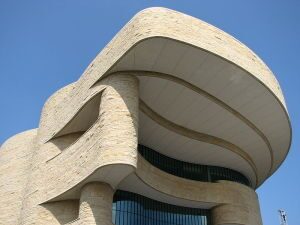
Few people know that the Smithsonian Institution curates one of the largest single collections of whole Mesoamerican ceramic artifacts in the world — more than 12,000, to be specific. But most of these objects are tucked away unseen by most people within the storage “vaults” that house all of the other massive museum collections, the largest in the world.
Now, after more than two years of research on the museum’s Central American ceramics collections under the sponsorship of the Smithsonian”s Latino Center, curator Ann McMullen and guest curator Alexander Villa Benitez of George Mason University have selected more than 160 objects from the museum’s vast collection of ancient ceramics from the region, and augmented it with other significant examples of work in gold, jade, copper, marble, shell and stone. The objects represent a rich variety of Central American cultures spanning the period from 1000 B.C. to the present, illustrating the complexity of Mesoamerican civilization in terms of social and trade networks, technology, artwork and systems of status and political organization. Under the rubric, Cerámica de los Ancestros: Central America’s Past Revealed, they are now shared in a public exhibition that examines seven regions representing distinct Central American cultural areas that are today part of Belize, Costa Rica, El Salvador, Guatemala, Honduras, Nicaragua and Panama.
“This is our first major exhibition that examines our remarkable Central American collection, which is world class based on its sheer size and the fact that these are whole and intact objects,” said Kevin Gover (Pawnee), director of the Smithsonian’s National Museum of the American Indian. “It also marks the first time that we have created a bilingual exhibition that will increase our scholarship and outreach to an entirely new audience.”
The exhibition is accompanied by an interactive website that includes 3-D images of select objects and a landmark publication, Revealing Ancestral Central America, edited by Rosemary A. Joyce.
The exhibition will be open through Feb. 1, 2015, in the third level W. Richard West Jr. Contemporary Arts Gallery at the National Museum of the American Indian in Washington, D.C.
__________________________
Source: Adapted and edited from a press release.
Cover Photo, Top Left: View of the National Museum of the American Indian. Abraham OFM, Wikimedia Commons
________________________________________________________________________________________________________________________
Read about the most fascinating discoveries with a premium subscription to Popular Archaeology Magazine. Find out what Popular Archaeology Magazine is all about. AND MORE:
 Popular Archaeology’s annual Discovery edition is a selection of the best stories published in Popular Archaeology Magazine in past issues, with an emphasis on some of the most significant, groundbreaking, or fascinating discoveries in the fields of archaeology and paleoanthropology and related fields. At least some of the articles have been updated or revised specifically for the Discovery edition. We can confidently say that there is no other single issue of an archaeology-related magazine, paper print or online, that contains as much major feature article content as this one. The latest issue, volume 2, has just been released. Go to the Discovery edition page for more information.
Popular Archaeology’s annual Discovery edition is a selection of the best stories published in Popular Archaeology Magazine in past issues, with an emphasis on some of the most significant, groundbreaking, or fascinating discoveries in the fields of archaeology and paleoanthropology and related fields. At least some of the articles have been updated or revised specifically for the Discovery edition. We can confidently say that there is no other single issue of an archaeology-related magazine, paper print or online, that contains as much major feature article content as this one. The latest issue, volume 2, has just been released. Go to the Discovery edition page for more information.
Subscription Price: A very affordable $5.75 for those who are not already premium subscribers of Popular Archaeology Magazine (It is FREE for premium subscribers to Popular Archaeology). Premium subscribers should email populararchaeology@gmail.com and request the special coupon code. Or, for the e-Book version, it can be purchased for only $3.99 at Amazon.com.




